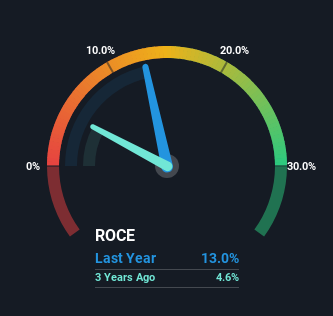
There are a few key trends to look for if we want to identify the next multi-bagger. Firstly, we'd want to identify a growing return on capital employed (ROCE) and then alongside that, an ever-increasing base of capital employed. Basically this means that a company has profitable initiatives that it can continue to reinvest in, which is a trait of a compounding machine. So when we looked at Pitney Bowes (NYSE:PBI) and its trend of ROCE, we really liked what we saw.
Our free stock report includes 4 warning signs investors should be aware of before investing in Pitney Bowes. Read for free now.Return On Capital Employed (ROCE): What Is It?
Just to clarify if you're unsure, ROCE is a metric for evaluating how much pre-tax income (in percentage terms) a company earns on the capital invested in its business. Analysts use this formula to calculate it for Pitney Bowes:
Return on Capital Employed = Earnings Before Interest and Tax (EBIT) ÷ (Total Assets - Current Liabilities)
0.13 = US$223m ÷ (US$3.4b - US$1.7b) (Based on the trailing twelve months to December 2024).
Therefore, Pitney Bowes has an ROCE of 13%. In absolute terms, that's a satisfactory return, but compared to the Commercial Services industry average of 11% it's much better.
Check out our latest analysis for Pitney Bowes

Above you can see how the current ROCE for Pitney Bowes compares to its prior returns on capital, but there's only so much you can tell from the past. If you'd like to see what analysts are forecasting going forward, you should check out our free analyst report for Pitney Bowes .
What The Trend Of ROCE Can Tell Us
Pitney Bowes has not disappointed in regards to ROCE growth. The data shows that returns on capital have increased by 118% over the trailing five years. The company is now earning US$0.1 per dollar of capital employed. Interestingly, the business may be becoming more efficient because it's applying 56% less capital than it was five years ago. Pitney Bowes may be selling some assets so it's worth investigating if the business has plans for future investments to increase returns further still.
For the record though, there was a noticeable increase in the company's current liabilities over the period, so we would attribute some of the ROCE growth to that. The current liabilities has increased to 49% of total assets, so the business is now more funded by the likes of its suppliers or short-term creditors. Given it's pretty high ratio, we'd remind investors that having current liabilities at those levels can bring about some risks in certain businesses.
In Conclusion...
From what we've seen above, Pitney Bowes has managed to increase it's returns on capital all the while reducing it's capital base. And with the stock having performed exceptionally well over the last five years, these patterns are being accounted for by investors. With that being said, we still think the promising fundamentals mean the company deserves some further due diligence.
If you'd like to know more about Pitney Bowes, we've spotted 4 warning signs, and 1 of them doesn't sit too well with us.
While Pitney Bowes may not currently earn the highest returns, we've compiled a list of companies that currently earn more than 25% return on equity. Check out this free list here.
Have feedback on this article? Concerned about the content? Get in touch with us directly. Alternatively, email editorial-team (at) simplywallst.com.
This article by Simply Wall St is general in nature. We provide commentary based on historical data and analyst forecasts only using an unbiased methodology and our articles are not intended to be financial advice. It does not constitute a recommendation to buy or sell any stock, and does not take account of your objectives, or your financial situation. We aim to bring you long-term focused analysis driven by fundamental data. Note that our analysis may not factor in the latest price-sensitive company announcements or qualitative material. Simply Wall St has no position in any stocks mentioned.